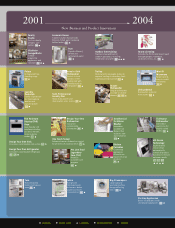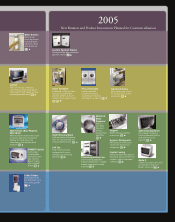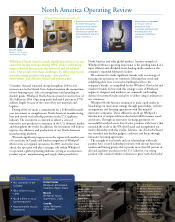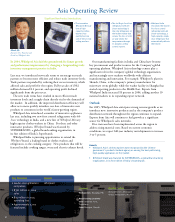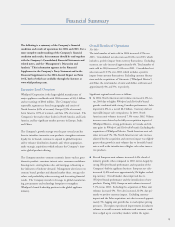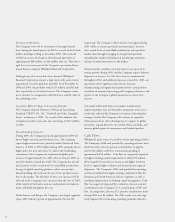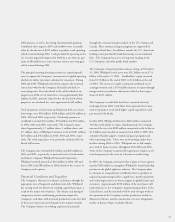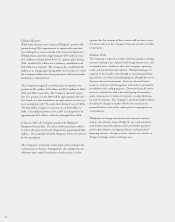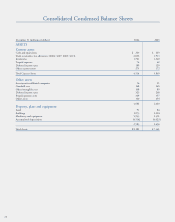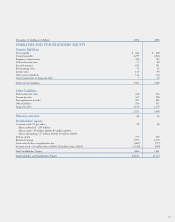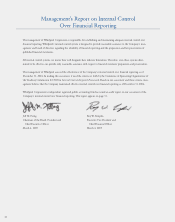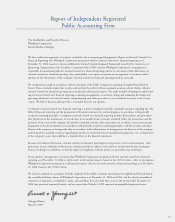Whirlpool 2004 Annual Report Download - page 26
Download and view the complete annual report
Please find page 26 of the 2004 Whirlpool annual report below. You can navigate through the pages in the report by either clicking on the pages listed below, or by using the keyword search tool below to find specific information within the annual report.
Discontinued Operations
The Company wrote off its investment in leveraged aircraft
leases during the fourth quarter of 2002 as a result of the United
Airlines bankruptcy filing in December 2002. The write-off
resulted in a non-cash charge to discontinued operations of
approximately $68 million, or $43 million after tax. These lever-
aged lease assets were part of the Company's previously discon-
tinued finance company, Whirlpool Financial Corporation.
Although most of its assets have been divested, Whirlpool
Financial Corporation remains a legal entity with assets consist-
ing primarily of a leveraged lease portfolio. As of December 31,
2004 and 2003, the portfolio totaled $15 million and $42 mil-
lion, respectively, net of related reserves. The Company contin-
ues to monitor its arrangements with the lessees and the value of
the underlying assets.
Cumulative Effect of Change in Accounting Principle
The Company adopted Statement of Financial Accounting
Standards (“SFAS”) No. 142, “Goodwill and Other Intangible
Assets,” on January 1, 2002. As a result of this adoption, the
Company recorded a non-cash, after-tax charge of $613 million
in 2002.
Forward-Looking Perspective
During 2004, the Company incurred approximately $300 mil-
lion of higher material and oil-related costs. The Company
expects higher material costs, primarily within North and Latin
America, of $500 to $550 million during 2005, primarily due to
higher prices for steel and resins. To address this challenging
environment, the Company has implemented global price
increases of approximately 5-to-10%, effective January 2005, in
most key markets around the world. The Company has also ini-
tiated actions to drive record levels of controllable productivity,
leverage its global operating platform, reduce non-product
related spending and accelerate the rate of new product innova-
tion to the market. The full effect of these cost increases will be
reflected in the Company's cost structure from the start of 2005,
while benefits of both price increases and productivity improve-
ments will build throughout the year.
North America and Europe, the Company's two largest segments,
expect 2005 industry growth of approximately 2% and 1%,
respectively. The Company's efforts in these two regions during
2005 will be to execute previously announced price increases,
drive record levels of controllable productivity, and expand its
market share through leveraging its strong brand portfolio,
expanding key market leadership and introducing continuous,
relevant, branded innovations to the market.
Macroeconomic conditions in Latin America are expected to
remain positive during 2005, and the Company expects industry
shipments to increase 4-to-5%. Price increases implemented
throughout 2004, and additional increases enacted for 2005, are
expected to offset significant material cost increases.
Manufacturing and supply chain productivity is anticipated to
contribute to improved operating profit margin performance and
exports to the Company's global operations are expected to
increase.
Asia results will benefit from new product introductions,
improved product mix and favorable comparisons to last year's
results that reflected the Company’s inventory trade-reduction
strategy in India. The Company will continue to expand its
China procurement and technology base to support its global
operations, expand domestic sales within China and India, and
increase global exports of components and finished product.
Cash Flows
Whirlpool's main source of cash flow is from operating activities.
The Company's 2004 cash provided by operating activities bene-
fited from lower after-tax pension contributions of approxi-
mately $62 million and lower restructuring spending of
approximately $56 million. Cash flow was negatively impacted
by higher working capital requirements of about $70 million,
driven largely by material cost increases and higher inventory
levels to support higher volumes and increased trans-regional
shipments. The Company's 2003 cash provided by operating
activities benefited from higher earnings, primarily within the
European and North American business segments, as well as
continued improvement in working capital management. Cash
flow was negatively impacted by a voluntary, after-tax pension
contribution to the Company's U.S. pension plans of $97 mil-
lion. In comparison, after-tax U.S. pension contributions made
during 2002 were $5 million. The 2003 results were also nega-
tively impacted by restructuring spending, primarily related to
22


